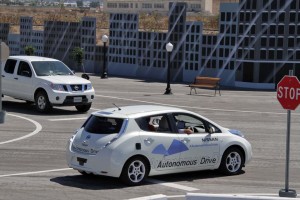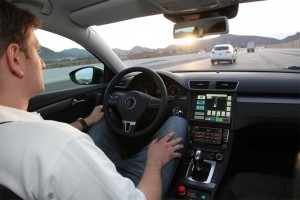Is the auto industry approaching a high-tech era of accident-free driving?
New rules in Europe going into effect in 2014 will require vehicles to have advanced driver assistance features such as lane departure and forward collision warning systems to get a top safety rating – and that’s accelerating the development of new driver-assist technologies that could sharply reduce the number of common accidents due to driver error, industry leaders predict.
The new rules, in turn, are bringing the age of fully automated driving ever closer, said Steffen Linkenbach, Continental AG director of engineering systems and technology, the German supplier pushing to become a leader in the fast-emerging field.

A prototype Nissan Leaf autonomous vehicle negotiates a simulated urban intersection, complete with cross traffic.
The emergence of earlier safety technologies such as seatbelts, anti-lock brakes and airbags contributed to significant declines in fatalities per miles driven, he said. Driver assistance features and automated driving will make the same kind of contribution, he predicted.
“We have a clear vision of accident-free driving,” said Likenbach. Continental, a major supplier of safety technology, has already sold 4.5 million sensors used for the latest driver-assist systems, and the total is expected to climb to 10 million by 2015. “We supply all the automakers,” aded Likenbach.
(Driving? Riding? Co-piloting? Click Here to go for a ride in Nissan’s autonomous vehicle prototype.)
Last January, Continental and BMW Group signed an agreement to jointly develop highly automated driving functions and to define the long-term prerequisites for making highly automated driving systems available in volume production for vehicles sold in Europe. The cooperative project runs through to the end of 2014.
Partially automated vehicles that still will need the assistance of an alert driver should be available by 2016 and more sophisticated versions by 2020, Linkenbach forecast, adding that fully automated driving systems will be available by 2025.
(That forecast may be conservative, however, Nissan recently promising to introduce its first mainstream fully-autonomous vehicle by 2020. Other makers anticipate reaching similar milestones around decade’s end, as well, Tesla CEO Elon Musk suggesting the battery-car maker is planning a “90% autonomous” vehicle by 2020.)
(For more on Tesla’s plans, Click Here.)
When the first generation of fully automated systems become available they still won’t be the stuff of science fiction movies, where a motorist can simply curl up in the back for a few minutes extra sleep while the vehicle handles the morning commute. For one thing, Linkenbach believes they will still be limited to driving on the freeway.
While competitors – such as Nissan – believe such vehicles may also be able to handle local roads, there’s general agreement the initial designs won’t completely relieve drivers of their responsibility to constantly pay attention to what is happening on the road. In fact, several U.S. states that have already created licensing programs for autonomous vehicle prototypes specifically require alert operators to remain seated behind the wheel in the event of an emergency.
(New technologies help drive down highway fatalities. Click Here for the latest.)
Nevertheless, during a drive on Detroit’s I-75 freeway in an autonomous test vehicle, Continental engineers showed off how far the technology has come. The test vehicle cruised along at 70 mph while the driver kept his hands off the wheel. A little later, it automatically maintained a safe position in stop-and-go traffic behind a Michigan Department of Transportation Crew re-painting lane markings on the freeway.
The driver, Ibro Muharemovic, a member of Continental Auto Systems advanced engineering system, said partially automated driving can take much of the tension and tedium out of a trip. The system relieves the frustration that comes with stop-and-go traffic and the tedium of long, boring drives on the freeway where falling asleep behind the wheel is a real danger, he said.
Continental’s Likenbach stressed a lot of research and development work is still needed before fully automated driving is possible, even along the straightest sections of roadways. Besides the technical challenges, the focus is on developing affordable systems and establishing a valid legal framework for automated driving, he said.
But the potential benefits are substantial, he added. The streets will be safer, traffic flow will improve and fuel consumption will decline and the driver will find they have more freedom and can better use the time in the car, Likenbach said.


Lotsa luck…